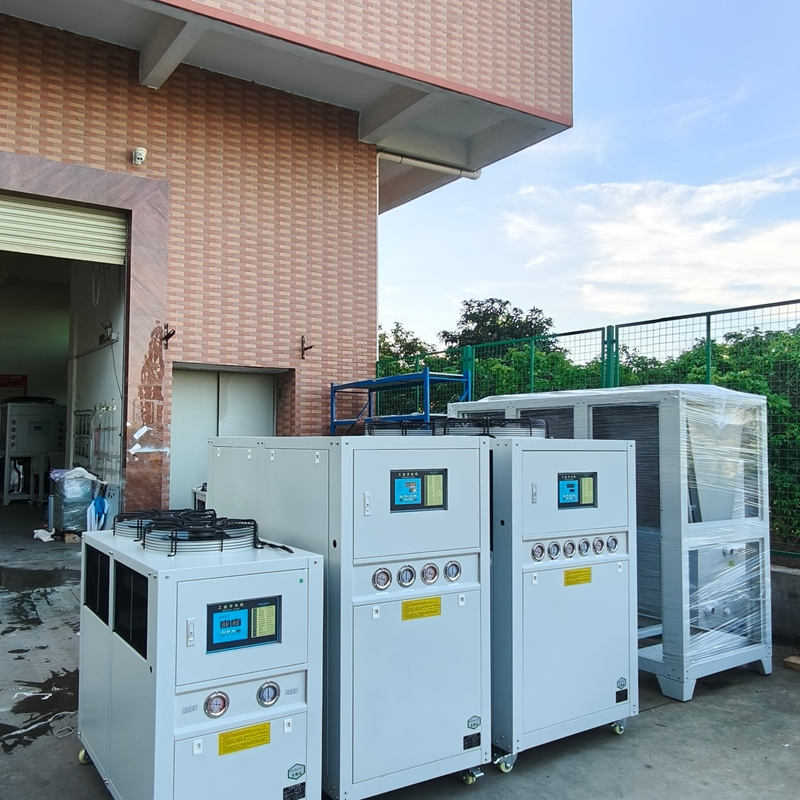The main features of air-cooled chillers can be summarized as "three simplicitys and one speed, one low and one high," namely, simple structure, easy installation, simple maintenance, fast investment, low initial investment, and high operating energy consumption. Below, Jianlong Hydraulic Machinery will analyze its core features in detail:

1. Core Advantages
1.1 Simple System, Convenient Installation
1.1.1 Integrated Design: The air-cooled chiller integrates the compressor, evaporator, air-cooled condenser, and fan into a single casing, forming a complete and independent system.
1.1.2 Easy Installation: Users only need to connect the power supply and chilled water circulation pipes to put it into use, eliminating the need for complex auxiliary equipment such as cooling towers, cooling water pumps, cooling water pipes, and corresponding water treatment systems. This greatly shortens the installation period and reduces the complexity of the installation project.
1.2 Lower Initial Investment Costs
Since there's no need to purchase and install expensive cooling towers, cooling water pumps, and extensive piping systems, the initial equipment investment and installation costs of air-cooled chillers are typically much lower than those of water-cooled systems with equivalent cooling capacity. This is very attractive for projects with limited budgets.
1.3 No Water Consumption, Water-Friendly
It relies entirely on air for heat dissipation and consumes no water during operation. This is a significant advantage in water-scarce areas or places where water costs are high.
1.4 Relatively Simple Maintenance
1.4.1 Maintenance mainly focuses on:
• Cleaning the condenser fins: Regularly removing dust, catkins, and other debris to maintain good heat exchange efficiency.
• Checking the fan motor: Ensuring the fan is operating normally.
1.4.2 Avoids the complex water treatment, scaling, corrosion, and Legionella prevention issues associated with water-cooled systems.
1.5 Relatively Flexible Footprint
The equipment itself does not require a dedicated machine room and can be installed on the roof, ground, or other well-ventilated outdoor spaces. While good ventilation is required, overall, it saves the large dedicated space required for cooling towers.
2. Core Disadvantages and Challenges
2.1 Lower Energy Efficiency and Higher Operating Costs
2.1.1 Root Cause: Air's specific heat capacity and thermal conductivity are far inferior to water, resulting in lower heat exchange efficiency for air-cooled condensers.
2.1.2 Result: The compressor needs to operate at higher condensing pressures and temperatures, leading to a heavier compressor load and higher power consumption. Typically, its coefficient of performance (COP) is 20%-40% lower than that of water-cooled chillers. Under long-term continuous operation, the high electricity costs negate its advantage of low initial investment.
2.2 Highly Affected by Ambient Temperature
Its cooling efficiency is directly affected by the ambient dry-bulb temperature. In the high temperatures of summer, higher ambient temperatures make heat dissipation more difficult, significantly reducing cooling efficiency and further increasing power consumption. In extreme temperatures, excessively high condensing pressure may even trigger a protective shutdown.
2.3 Higher Operating Noise
To enhance air heat exchange, high-power axial fans are required for forced ventilation, and these fans are the main source of noise. For projects located near office or residential areas, noise issues require careful consideration and management.
2.4 Heat Exhaust Impacts the Surrounding Environment
It directly discharges waste heat generated during the cooling process into the surrounding environment as hot air. If the installation space is narrow or ventilation is poor, hot air recirculation can occur, further worsening heat dissipation conditions and potentially raising the local ambient temperature of the installation area.
2.5 Relatively Limited Unit Capacity
Due to limitations in air heat exchange efficiency and fan size, the unit capacity of air-cooled chillers is usually not as large as that of water-cooled chillers. While larger cooling capacities can be achieved through modular assembly, their economic and space advantages are diminished in ultra-large projects.

Air-cooled chillers are a type of equipment with "low initial investment but high subsequent electricity costs." They trade lower energy efficiency for system simplicity, easy installation, and lower initial costs. For more information/advice on air-cooled chillers or to purchase other high-quality hydraulic presses, please contact us (or scan the WhatsApp QR code below). Jianlong Hydraulic Technology will provide you with personalized and customized professional solutions and is dedicated to serving you.

Contact: Miss.Li
Phone: 18822971180
Tel: 86-18822971180
Email: lifuyan78@gmail.com
Add: Guangyi Industrial Park, No. 2, Tanglip Jinfu West Road, Liaobu Town, Dongguan City, China
We chat
